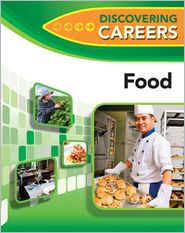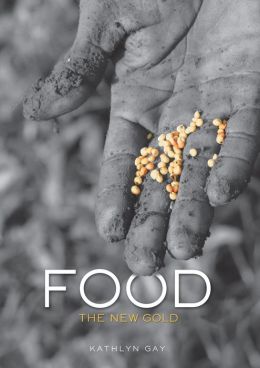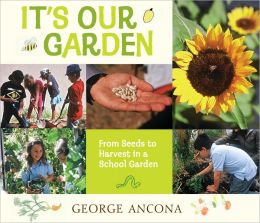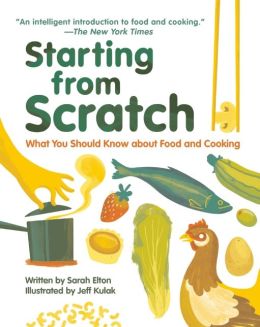 |
Bring Me Some Apples and I’ll Make You a Pie: A Story about Edna Lewis Robbin Gourley In her children’s book debut, cookbook author/illustrator Gourley (Cakewalk) celebrates food, as cultivated on a farm and as used to cultivate family bonds. Recounting African-American chef Edna Lewis’s childhood in a Virginia farming community, the cheery watercolor spreads follow Edna and various relatives (“Sister,” “Daddy,” “Auntie”) from spring to first snow as they harvest strawberries, dandelion greens, peaches, pecans and more. Edna appreciates each crop, as well as the honey-gathering: “A swarm of bees in May is worth a load of hay./ A swarm of bees in June is worth a silver spoon./ A swarm of bees in July is not worth a fly,” she recites; similar folk sayings or songs accompany mention of each new food, proof of its centrality to the characters’ happiness. Dynamic paintings, increasingly lush as summer intensifies, add vigor. Children whose experience of food supply is limited to grocery stores, school cafeterias and other eateries will relish this nostalgic view. A short biography of the late Lewis concludes the narrative, and five mouth-watering recipes for Southern staples are welcome extras. 2009, Clarion, Ages 4-8, $16.00. REVIEWER: Publishers Weekly (Publishers Weekly). ISBN: 9780618158362 |
 |
Cooking Up A Storm: The Teen Survival Cookbook Sam Stern, with Susan Stern Cooking Up A Storm: The Teen Survival Cookbook by Sam Stern (and inspired by great British chefs such as Jamie Oliver, Gordon Ramsay, and Nigella Lawson) is an expansive and “teen-friendly” guide through a fun, nutritious, delicious, and easy-to-prepare collection of recipes that kids can make in their family kitchen. Ably presenting a culinary wealth of recipes for active meals and the step-by-step methods for their preparation (including an ingredients list for each featured dish), Cooking Up A Storm: The Teen Survival Cookbook offers its young readers recipes ranging from My Friend Joe’s Thai Green Curry; Meringue Shells with Raspberries and Cream; and Tomato, Avocado and Mozzarella Salad; to Our Fave Cheesecake; Chocolate Crispy Crunchies; and French Onion Soup with Cheese Croutons. A welcome addition to any family cookbook shelf, Cooking Up A Storm: The Teen Survival Cookbook is very highly recommended for all teens eager to discover their hidden culinary talents or who must begin to assume meal preparation duties for themselves and/or their families. 2006, Candlewick Press, Ages 12 up, $16.99. REVIEWER: Midwest Book Review (Children’s Bookwatch). ISBN: 9780763629885 |
 |
Eat Fresh Food: Awesome Recipes for Teen Chefs Rozanne Gold and her all-star team Photographs by Phil Mansfield This cookbook would be really good if it was not geared toward teenagers. The navigation tools, like the table of contents and the index, are great, and the formatting is consistent and clear. The pictures are beautiful and fun to look at, and I really like that the titles of each recipe are color-coded to match the ingredients. Throughout the recipes are little tips that, as someone who has never cooked a thing in her life, would be really helpful while attempting something new. The suggested menus at the back of the book were also a nice feature. The overall tone of the cookbook, the “let’s get teenagers excited about cooking fresh” theme, however, just does not really succeed. Although still a worthwhile read, it would have been so much better if it did not try so hard to appeal to teenagers. 2009, Bloomsbury, Ages 11 to 18, $17.99 REVIEWER: Mary Boutet, Teen Reviewer (VOYA). ISBN: 9781599904450 |
 |
Farmer Will Allen and the Growing Table Jacqueline Briggs Martin Illustrated by Eric-Shabazz Larkin How former basketball star Will Allen turns a vision into reality is the subject of this lively and engaging picture book biography. As Allen was beginning his professional basketball career in Belgium, he was quite sure he never wanted to weed or work in a garden again. Years later in Milwaukee, as he looked upon an abandoned plot of land with six empty greenhouses, he had a vision of kids “sitting at his table, eating his vegetables.” His vision grew into Growing Power, which has revolutionized urban farming. Intrigue and excitement builds in Martin’s deftly written, upbeat text as Allen expands his farm and its concept – first locally, then nationally, and then internationally. The text is clear, concise, informative and lively. The illustrations expand upon the text and just naturally seem to draw in the reader. The layout is welcoming. Chapter headings let the reader know what will be discussed in the very short (often two pages) chapters. It is ideal for the emerging reader, the older reluctant reader, and also for a middle school or high school classroom or community group discussion of urban farming, community cooperation, and role models. Don’t miss the illustration of the Statue of Liberty with vegetables in hand and Will Allen, who had been so large in prior illustrations, waving to her from a rooftop garden. Both text and illustrations encourage discussion. Every time I open this book, I see and read more and more. REVIEWER: Sharon Salluzzo (Children’s Literature). ISBN: 9780983661535 |
 |
Food Facts on File Discovering careers series. 2011, Ferguson’s, Ages 10-15, $27.00. REVIEWER: Ann Kelley (Booklist). ISBN: 9780816080571 |
 |
Food: The New Gold Kathlyn Gay The sobering statement that one billion of the world’s population is undernourished, with millions more starving, although more than enough food is produced each year to feed everyone, is the focus of this nonfiction book for the middle grades. Using non-biased language and balanced information, this is filled with colorful maps, interesting photos, and personal commentaries, all used to succinctly explain the causes of food shortages and detail its production around the world. Topics are explained using their most essential information, without confusing or meandering subtopics or other less germane subjects. Asserting the main cause of hunger is poverty, chapters discuss food production challenges, including corporate factory farms replacing family ones; natural resource depletion; poor animal and worker treatment (a sobering section, though told rather than shown); pollution and pesticides; climate/weather factors; and genetic engineering. Also discussed are the politics surrounding food, revealing that finances are decisive and divisive. This is specifically demonstrated through school lunch systems, and in cases where food is used as a weapon, especially in poorer countries. The slim volume concludes with future food sources, such as pills and insects, reminiscent of Soylent Green, for those old enough to remember the movie. An impressive reference section includes an extensive glossary and source notes, bibliography, books, films, Web sites, and an index. While this book may not be immediately of interest to students, it is ideal for school reports or other assignments on this topic, and middle school readers will find themselves engrossed once they begin reading this honest and interesting text. 2012, Twenty-First Century/Lerner, Ages 11 to 15, $31.93. REVIEWER: Lisa Hazlett (VOYA). ISBN: 9780761346074 |
 |
The Good Garden: How One Family Went From Hunger to Having Enough Katie Smith Milway Illustrated by Sylvie Daigneault Part of the CitizenKid line of books, this inspiring story uses the example of a Honduran family to explain the global plight of farmers who aren’t able to feed and support themselves despite their labors. With their land past its prime and at the mercy of a predatory grain buyer (portrayed as a well-dressed coyote), MarA a Luz Duarte and her parents fear they will lose their farm. A new teacher, however, explains how composting and terrace farming can help, eventually allowing the family to circumvent the middleman and thrive. 2010, Kids Can, Ages 7 to10, $18.95. REVIEWERS: Publishers Weekly (Publishers Weekly). ISBN: 9781554534883 |
 |
It’s Our Garden: From Seeds to Harvest in a School Garden George Ancona Mrs. McCarthy dreamed of having a school garden. With special permission from the school and parents, she was able to bring her dream to life. Miss Sue helps care for the garden. Her husband helped design the layout. Some students from the local college volunteered to guide the children in the garden projects. There are a lot of chores to be done. Sometimes classes are held in the open classroom, the garden, or the greenhouse. In the spring, the students cut out pictures from the seed catalogs. Then they decide where to plant the seeds. They make their own compost and mix it into the garden beds as plant food. Children get in on the fun of experimenting with varieties of fruit and vegetable plants available to them. There are a lot of things in the garden to write and draw about. A teacher orders butterfly cocoons by mail. The students raise them in the classroom. This book is a great way to get children interested in gardening and growing their own food. The author used beautiful pictures of children leaning and working together. There is even a section on the types of bugs that hang around a garden and what to do about them. A great read! 2013, Candlewick, Ages 5 to 8, $16.99. REVIEWER: Beverly Melasi (Children’s Literature). ISBN: 9780763653927 |
 |
The Omnivore’s Dilemma: The Secrets Behind What You Eat Michael Pollan Adapted by Richie Chevat This adaptation of Michael Pollan’s thought-provoking adult book of the same name examines where our food comes from in the United States, and discusses decisions we make regarding what to purchase and consume in terms of health, economics, and social justice. In large part an indictment of industrial food production, Pollan’s book invites readers to consider alternatives as he explores industrial organic farming, local sustainable farming, and hunting, gathering, and gardened food. He documents his journey of discovery about each in a narrative peppered with numerous informational sidebars (although the black-and-white graphics lack dynamics). Pollan glosses over how class and economics impact decision-making, but his work is still an effective starting point for thinking about food. It includes tips for voting “with your fork” and numerous sources for more information. 2009, Dial, Age 12 and older, $17.99. REVIEWER: CCBC (Cooperative Children’s Book Center Choices). ISBN: 9780803734159 |
 |
Simply in Season Children’s Cookbook Mark Beach Part of the “World Community Cookbooks” series commissioned by the Mennonite Central Committee to promote the understanding of how food choices affect our lives and the lives of those who produce the food we eat, this is one of the best teaching-cookbooks you could add to your collection. Arranged by season, the recipes celebrate the fresh bounty of the earth with low food miles. No strawberries from Argentina in January. Each season’s recipes are preceded by an overview introduction to five fresh ingredients with clear photos of them as they are being used, as well as while they are growing. Food facts dot the text unobtrusively, and then come the recipes. Directions are clear and simple, photographs are appealing. Each seasonal chapter begins with a handsome art piece comprised of the fresh ingredients of the season and a short poem. Between chapters is a short prayer of thanks titled “Around the Table.” The ingredients are used as photographic decoration for the pages, which are edged with green, red, orange, and purple to visually divide spring, summer, fall, and winter. An additional section about herbs and a template page for readers to draw or photograph their own garden ingredients adds more teaching possibilities. Recipes are all kid-tested and easily prepared by kids. The emphasis is on fresh and simple local produce; nothing canned or packaged. The index has pictures of the produce as well as page numbers–a unique feature. The bad news about this cookbook is that once you have had a chance to read and savor its simple celebration of good local food, you will want to accumulate the rest of the series: Simply In Season (eat fresh, buy locally, support local farmers), More-With-Less (eat better, consume less), and Extending the Table (dishes from around the world interspersed with stories of hospitality). 2006, Herald Press, Ages 6 to 14, $21.00. REVIEWER: Gwynne Spencer (Children’s Literature). ISBN: 9780836193367 |
 |
Starting From Scratch: What You Should Know about Food and Cooking Sarah Elton Illustration by Jeff Kulak The brightly colored cover with graphics in shades of green and yellow set the tone for this upbeat, informal, but thorough, book about all things food. Canadian food writer Elton’s breezy text covers the importance of taste and what’s behind it, how food makes us who we are, the science of cooking, the ins and outs of recipes, getting set and using the kitchen, good cooking everyday. The ethics of cooking (religious traditions, sustainability), cooking safety, cleanliness, and even setting the table are included! Elton encourages good cooking everyday and shows it needn’t be complicated. She also encourages trying new foods and cuisines; in that same section she reveals the 5 Cs of cuisine: crop, climate, caravan, and creativity. Using fresh when possible is emphasized, but an evenhanded discussion the “wacky world of flavor science” is included. Food fact sidebars are colorfully sprinkled throughout and there are occasional informational sidebars as well. Appendices covering basic recipes, flavor pairings, measurements and conversions follow the text, as do a few recommended cookbooks and an index. Kulak’s retro-style illustrations complement the lively text, creatively and humorously portraying key elements of the text. There is a lot of information contained within, but the colorful graphics break up the text as well as pull in the reader. A combination of philosophical and practical, the book is highly readable, written in a way to engage tweens and teens–and their parents. 2014, Owlkids, Ages 10 up, $18.95. REVIEWER: Peg Glisson (Children’s Literature). ISBN: 9781926973968 |
 |
What the World Eats Faith D’Aluisio Photographed by Peter Menzel If you have ever wondered what your counterparts around the world eat for their daily meals, some answers can be found in this impressive book. It takes a look at what a typical family in a variety of countries buys for a weeks worth of groceries. The families are pictured with the food and the cost is given in local and U.S. dollars. In addition, the foods are categorized: grains; dairy; meat, fish and eggs; fruits and vegetables; condiments; snacks; prepared food; fast food; beverages; and miscellaneous. Readers are presented with a fact box that summarizes information about the country and a presents a section of a world map to show where that country is located. The pages that follow describe life in that part of the world and how the family shops. There are also recipes of some of the traditional foods. A reader might assume that those from wealthier countries who have a variety of foods from around the world might have a healthier diet, but that is not always the case. Major and abrupt changes in diet such as those of aboriginal Australians, Native Americans and the like can bring on diseases like diabetes and issues related to obesity. The book is a treasure trove of facts most of which are presented in graphs and charts. Some that are really intriguing include the number of McDonald’s restaurants and a comparison of the overweight and obese populations. You can see a correlation. Other charts relate information about annual meat consumption, life expectancy, access to safe water, literacy rate and fertility rates. There is extensive back matter including books, films, websites and lists of sources plus an extensive index. The author has created an excellent book for reference, report writing and browsing. 2008, Tricycle/Ten Speed Press, Ages 10 up, $22.99. REVIEWER: Marilyn Courtot (Children’s Literature). ISBN: 9781582462462 |
 |
Who Wants Pizza?: The Kids’ Guide to The History, Science and Culture of Food Jan Thornhill Written by an award winning writer and illustrator of books for children, this introduction to the wonderful (and wacky) world of food is just what is needed to get youngsters interested in what they put in their mouths and how that effects their bodies. Visually arresting with its myriad of color photos and boxed texts, the book is divided into four sections: Why Eat? which includes how our bodies use food and how we react to food; How It All Started, includes how humans evolved from nomads to farmers to food preservers to chefs; Changing Food, including how food production has changed over the years and Food for Thought, featuring how production is impacting the world and why food choices matter. The variety of issues within this framework is fascinating and should lead to some interesting discussion as well as further research. A brief glossary and sources for further study are included, as well as an index. 2010, Maple Tree Press, Ages 8 to 11, $12.95. REVIEWER: Meredith Kiger, Ph.D. (Children’s Literature). ISBN: 9781897349960 |
Food and Cooking
 |
Why do we eat? What do we eat? Why do we eat what we eat? How is food grown and prepared? Encourage the youngsters in your life to be knowledgeable about what they eat and to cook for themselves (and others)-these books will help with that goal. Web links to additional information and activities about food and cooking follow these reviews. Contributor: Peg Glisson |
Reviews
|



